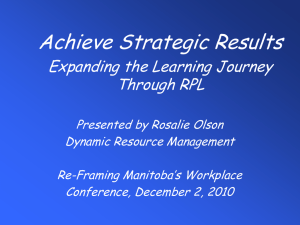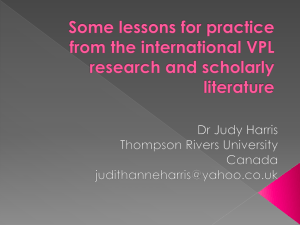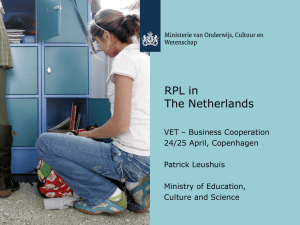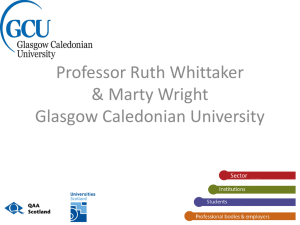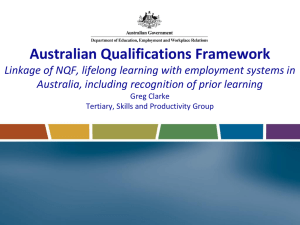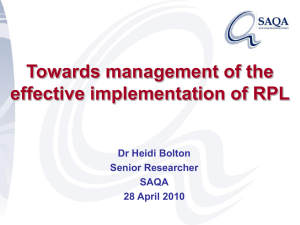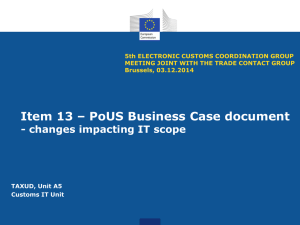Implementing Recognition of Prior Learning: Agriculture
advertisement
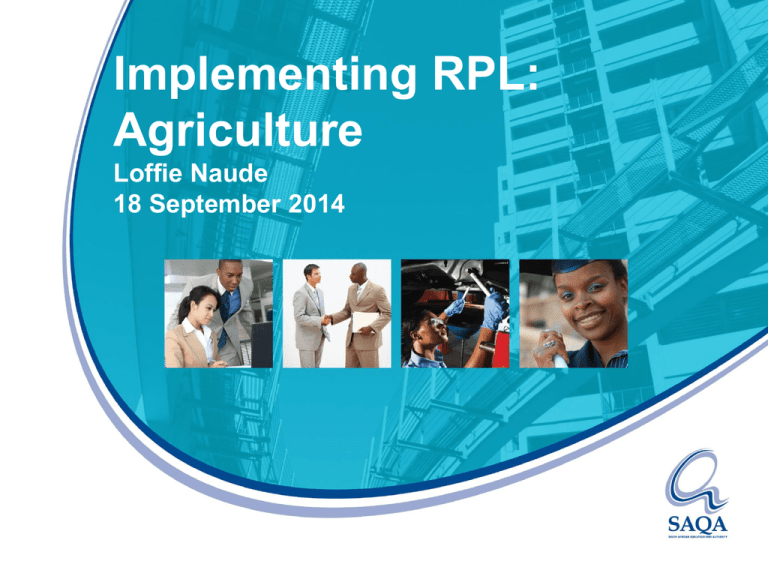
Implementing RPL: Agriculture Loffie Naude 18 September 2014 1 NQF & RPL RPL case studies Purpose 4 Terms 2 Objectives 5 RPL in South Africa 3 Scope 6 RPL and the NQF Projects 7 Looking forward Policy priorities 8 Responsibilities for implementation 9 Transitional arrangements NQF and RPL The NQF The NQF is a single integrated system which comprises of three co-ordinated qualifications sub-frameworks: 1. 2. 3. General and Further Education and Training Qualifications Subframework (GFETQSF) overseen by Umalusi Higher Education Qualifications Sub-framework (HEQSF) overseen by the CHE Occupational Qualifications Sub-framework (OQSF) overseen by the QCTO The sub-frameworks were determined on 14 December 2012 and amended on 30 August 2013; the sub-framework policies for the GFETQSF and HEQSF were determined on 2 August 2013 (the OQSF policy will be finalised in the near future) National Qualifications Framework 10 Doctoral Degree Doctoral Degree (Professional) * 9 Master’s Degree Master’s Degree (Professional) * 8 Bachelor Honours Degree Postgraduate Diploma Bachelor’s Degree Occupational Certificate (Level 8) 7 Bachelor’s Degree Advanced Diploma Occupational Certificate (Level 7) 6 Diploma Advanced Certificate Occupational Certificate (Level 6) 5 Higher Certificate Occupational Certificate (Level 5) 4 National Certificate Occupational Certificate (Level 4) 3 Intermediate Certificate Occupational Certificate (Level 3) 2 Elementary Certificate Occupational Certificate (Level 2) 1 General Certificate Occupational Certificate (Level 1) * Qualification types beyond Level 8 on the OQSF have not been determined Occupational Qualifications Sub-Framework Higher Education Qualifications SubFramework Sub-framework and qualification types General and Further Education and Training Qualifications SubFramework Level “Of all the expectations placed on the NQF, the aspiration for a system of prior learning was perhaps the most significant” Study Team on the Implementation of the NQF, April 2002 RPL since 2011 • RPL implemented by over 253 providers • SAQA is currently assisting with over 20 organisational RPL initiatives, with potential to reach 200,000 • 22 of 23 HEI implementing (12 have decentralised models, 10 centralised) • RPL known in the following sectors: Manufacturing and Engineering/ Chemical Industry/ Mining Industry/ materials Handling Equipment/ Banking sector/ Financial Services/ Business Practice/ Wholesale and Retail sector/ Labour broking/ Education and Training/ Public Service/ Media; Print, radio, TV/Public Service/Real Estate • NAMB is championing ARPL (seven steps towards becoming an artisan, including RPL) • Estimated numbers: 51,000+ Back COORDINATED APPROACH TO RPL SAQA Research Partnership with UWC SAQA RPL Reference Group RPL Conference 2014 New National RPL Policy 2013 Existing SAQA RPL Policy (2002, 2003) Strategic RPL projects Ministerial RPL Task Team SAQA website, NQF website, RPL portal RPL Policy Implementation Plan 2014-2019 WHAT IS RPL? Principles and processes through which Prior knowledge and skills are Made visible Mediated Assessed for the purposes of Alternative access Admission Recognition Certification Further learning Development FORMS OF RPL Alternative access route for those that do not meet formal entry requirements Applies to accredited providers and workplaces RPL for access RPL for credits Credits for, or towards, a qualification or part qualification registered on the NQF The revised National Policy for RPL Implementation PURPOSE • Position RPL in relation to NQF principles and priorities • Ensure that implementation is achieved by: • a comprehensive, quality-assured, resourcedriven approach • ensuring quality assurance and benchmarking of RPL overseen by SAQA and the three Quality Councils • addressing barriers • Recognising different kinds of RPL/ purposes for RPL • Providing for national co-ordination Back OBJECTIVES • Provide for implementation of RPL (resourcing, effective delivery, quality assurance) • Enable shared understanding, holistic RPL • Enable sector criteria/ institutional policies • Set national guidelines for implementation, and gathering/documenting/reporting RPL • Enable candidates to attain recognition for personal development, access, or progression in learning or work • Recognise roles of the various role-players • Enable national coordination of RPL by SAQA (research, support, advocacy, mainstreaming) Back SCOPE • Provides for the role of SAQA in co-ordinating the development of RPL policies and practices across all sub-frameworks of the NQF in co-operation with: • the three Quality Councils • education institutions and skills development providers • workplaces • assessment sites • recognised professional bodies • RPL practitioners Back TERMS RPL – the principles and processes through which the prior knowledge and skills of a person are made visible, mediated and assessed for the purposes of alternative access and admission, recognition and certification, or further learning and development RPL practitioner – a person that functions in one or more aspects of RPL provision (including policy development, advising, portfolio course design and facilitation, assessment and moderation, administration, monitoring and evaluation, research and development) Back RPL IN SOUTH AFRICA • The RPL process is multi-dimensional and multicontextual and holistic • RPL may be carried out at any level of learning and at any NQF level • The following principles are important: • The focus is on what has been learned, not on the status of the institution/organisation/place where the learning was obtained. • Credit is awarded for knowledge and skills acquired through experience and not for experience alone. • Prior learning is made explicit through assessment and/or other methods • Candidate guidance and support, preparation of evidence, appropriate teaching and learning, mentoring and assessment are key. Back RPL & THE NQF • NQF qualifications/part-qualifications may be awarded in whole or in part through RPL ---must include provision for alternative entrylevel requirements so candidates can be admitted to study towards the qualification, or part-qualification, through RPL • No distinction (other than for data analysis) can be made between achievements obtained via RPL/ conventional means • Providers must record/ submit RPL data through the relevant QC Back POLICY PRIORITY 1: QUALITY ASSURANCE OF RPL • Establishment of and adherence to policies, standards, processes, and associated practices • Standardised practices must grow within sectors (one approach may not work across different contexts) • Quality indicators such as fitness for purpose, transparency, and fair outcomes – are needed • Integrity of processes and outcomes needs to be protected POLICY PRIORITY 2: RESOURCING OF RPL • Includes direct and indirect physical, infrastructural, human, financial capacity to build and maintain sustainable mainstream RPL • Opportunities must be created for equitable access to RPL (redress) • Government/ other subsidisation of RPL must be identified by SAQA • Private sector RPL needs to be encouraged • Consistent pricing of RPL needed • Sharing RPL facilities, staff, expertise across institutions is encouraged POLICY PRIORITY 3: EFFECTIVE DELIVERY OF RPL • Delivery must take cognisance of lessons learned (in research, practice) • RPL for returning-to-learning youth and adults is encouraged and needs to be resourced in collaboration with all relevant stakeholders • RPL needs to be expanded with targets in workplaces and institutions of learning • RPL as tool for transformation needs to benefit those speaking all languages, not only the dominant language(s) • Identify • Initiate • Major industrial sector • Public sector • Sectorspecific centres • Community education and training • • • • Conduct Monitor Evaluate Benchmark Advocacy Initiate Encourage Guide Support Support and advice • • • • Strategic projects • Conduct • Coordinate • Disseminate Professionalisation Research POLICY PRIORITY 4: NATIONAL RPL COORDINATION • Marketing • Public perception of RPL • Conference in 2014 Back SUMMARY: SAQA RESPONSIBILITIES • Develop national policy and criteria • Co-ordinate the sub-frameworks of the NQF, including the alignment of sub-framework policies on RPL, and articulation across the system • Recognise professional bodies and register professional designations (specification of an RPL route is a requirement for listing of professional designations) • Oversee the national coordination of RPL SUMMARY: QUALITY COUNCIL RESPONSIBILITIES • Develop RPL policy for the sub-framework, monitor/evaluate implementation (providers) • Collaborate/ foster relationships with SAQA, NAMB, SETAs, professional bodies and others • Facilitate and monitor enabling agreements, and training of RPL advisors, facilitators, assessors, moderators, and administrators • Ensure consistency in RPL policy application • Support co-ordinated development of generic RPL toolkits and instruments • Ensure no distinction between conventional and RPL achievements • Conduct and oversee RPL-related research SUMMARY: RESPONSIBILITIES OF PROVIDERS • Progressively develop capacity to implement RPL, ensure staff capacity, effective planning, funding • Collaborate with SAQA, NAMB, the Quality Councils, professional to advance RPL implementation, monitoring, evaluation • Incentivise and support the registration and CPD of RPL practitioners • Provide advice, counselling and other support services for RPL candidates throughout • Establish an appeal process for RPL • Ensure an equitable fee structure • Develop an information management system SUMMARY: RESPONSIBILITIES OF PROFESSIONAL BODIES • Comply with national policy and criteria for the recognition of professional bodies and the registration of professional designations • Include an RPL route as an integral requirement for attainment of professional designations • Collaborate with SAQA, the Quality Councils and the relevant providers to incentivise and advance quality RPL provisioning • Progressively develop and enhance capacity to initiate and support RPL provision in accordance with this policy SUMMARY: RESPONSIBILITIES OF RPL PRACTITIONERS • Adhere to requirements set out in this policy and determined by the relevant bodies and governance structures, which may include a Quality Council, a workplace and a professional body • Meet professional requirements, including participation in continuing professional development activities, to be developed and agreed with the community of RPL practitioners, relevant bodies and governance structures through the national coordination of RPL as set out in this policy SUMMARY: RESPONSIBILITIES OF RPL CANDIDATES • Accept co-responsibility as an equal partner in the RPL process. • Expect to be treated without unfair discrimination. • Respect the processes and procedures of institutions and workplaces. Back TRANSITIONAL ARRANGEMENTS • The Criteria and guidelines for the implementation of RPL developed in 2004 by SAQA will be replaced by new guidelines as soon as these have been developed. • This policy comes into effect on the date of its publication(March 2013). • This policy replaces The recognition of prior learning in the context of the South African NQF policy developed in 2002 by SAQA. Back PROJECTS SAQA STRATEGIC RPL PROJECTS SAPS band members in partnership with Trinity College London Department of Public Service Administration Marine Industry Association of South Africa (MIASA) in cooperation with NAMB Community Development Practitioners in partnership with Department of Social Development, Department of Cooperative Governance, ETDP SETA DENOSA and Nursing Colleges Education Labour Relations Council Game Rangers in partnership with Rhodes University, the World Wildlife Federation (WWF) and SANParks Grain Silo industry with Deloitte e.TV Support to SASCOC for SA Coaching Framework development Support to the SANDF war veterans Correctional services to develop an RPL model for offenders towards NCV, and N courses Looking forward A FOCUS ON IMPLEMENTATION • With stability in the system, as confirmed by the White Paper on PSET, SAQA will have the opportunity to focus on implementation • This will include: • Monitoring and evaluation • Interventions where required (e.g. for RPL, short courses, international qualifications) • Strategic partnerships • Strong emphasis on advocacy and communication ALTERNATIVE ACCESS Process QUALIFICATION ASSESSMENT Leveling INFORMAL LEARNING WORKPLACE EXPERIENCE LIFE EXPERIENCE FORMAL LEARNING UNIVERSITY TVET COLLEGE SCHOOL WHO WILL BE THE DRIVER? • AgriSETA? • Department of Agriculture? • Unions? • OR • RPL Centre with collaboration between all relevant entities? LEARNER-CENTREDNESS LEARNER-CENTREDNESS • The learner is at the centre of the RPL process – human dignity • RPL provides opportunities for further development • RPL aims to redress past imbalances • RPL provides support to learners towards success • RPL is a change agent LEARNER-CENTREDNESS • For a while it is possible for an outsider to build a man’s house but an outsider cannot give a man pride and self-confidence… Those things a man has to create for himself by his own actions. He develops himself by what he does…by making his own decisions, by increasing his understanding of what he is doing and why; by his own full participation – Julius Nyerere. RPL CHALLENGES Systemic issues Organisational issues Funding Personal factors Transfer of knowledge RPL is a boundary shifting agent aiming at recognition of knowledge gained informally and nonformally – addressing the educational needs of all workers THANK YOU!
